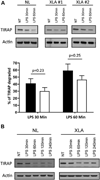Toll-like receptor 4-, 7-, and 8-activated myeloid cells from patients with X-linked agammaglobulinemia produce enhanced inflammatory cytokines
- PMID: 22088613
- PMCID: PMC3428022
- DOI: 10.1016/j.jaci.2011.10.009
Toll-like receptor 4-, 7-, and 8-activated myeloid cells from patients with X-linked agammaglobulinemia produce enhanced inflammatory cytokines
Abstract
Background: Bruton tyrosine kinase (BTK) is a component of signaling pathways downstream from Toll-like receptors (TLRs) 2, 4, 7, 8, and 9. Previous work in BTK-deficient mice, cell lines, and cultured cells from patients with X-linked agammaglobulinemia (XLA) suggested defective TLR-driven cytokine production.
Objective: We sought to compare TLR-4-, TLR-7-, and TLR-8-induced cytokine production of primary cells from patients with XLA with that seen in control cells.
Methods: PBMCs from patients with XLA, freshly isolated plasmacytoid dendritic cells, monocytes, and monocytoid dendritic cells were activated with TLR-4, TLR-7, and TLR-8 agonists. Signaling intermediates and intracellular and secreted cytokine levels were compared with those seen in control cells.
Results: Although TLR-4, TLR-7, and TLR-8 activation of nuclear factor κB and mitogen-activated protein kinase pathways in cells from patients with XLA and control cells were comparable, TLR-activated freshly isolated monocytes and monocytoid dendritic cells from patients with XLA produced significantly more TNF-α, IL-6, and IL-10 than control cells. TLR-7/8-activated plasmacytoid dendritic cells produced normal amounts of IFN-α. In murine models BTK regulates the degradation of Toll-IL-1 receptor domain-containing adaptor protein, terminating TLR-4-induced cytokine production. Although this might explain the heightened TLR-4-driven cytokine production we observed, Toll-IL-1 receptor domain-containing adaptor protein degradation is intact in cells from patients with XLA, excluding this explanation.
Conclusion: In contrast to previous studies with BTK-deficient mice, cell lines, and cultured cells from patients with XLA suggesting impaired TLR-driven cytokine production, these data suggest that BTK inhibits TLR-induced cytokine production in primary human cells.
Copyright © 2011 American Academy of Allergy, Asthma & Immunology. Published by Mosby, Inc. All rights reserved.
Conflict of interest statement
Disclosure of potential conflict of interest: The authors declare that they have no relevant conflicts of interest.
Figures




References
-
- Hennessy EJ, Parker AE, O’Neill LA. Targeting Toll-like receptors: emerging therapeutics? Nat Rev Drug Discov. 2010;9:293–307. - PubMed
-
- Pisitkun P, Deane JA, Difilippantonio MJ, Tarasenko T, Satterthwaite AB, Bolland S. Autoreactive B cell responses to RNA-related antigens due to TLR7 gene duplication. Science. 2006;312:1669–1672. - PubMed
-
- Uckun FM, Qazi S. Bruton’s tyrosine kinase as a molecular target in treatment of leukemias and lymphomas as well as inflammatory disorders and autoimmunity. Expert Opin Ther Pat. 2010;20:1457–1470. - PubMed
Publication types
MeSH terms
Substances
Supplementary concepts
Grants and funding
LinkOut - more resources
Full Text Sources
Miscellaneous

